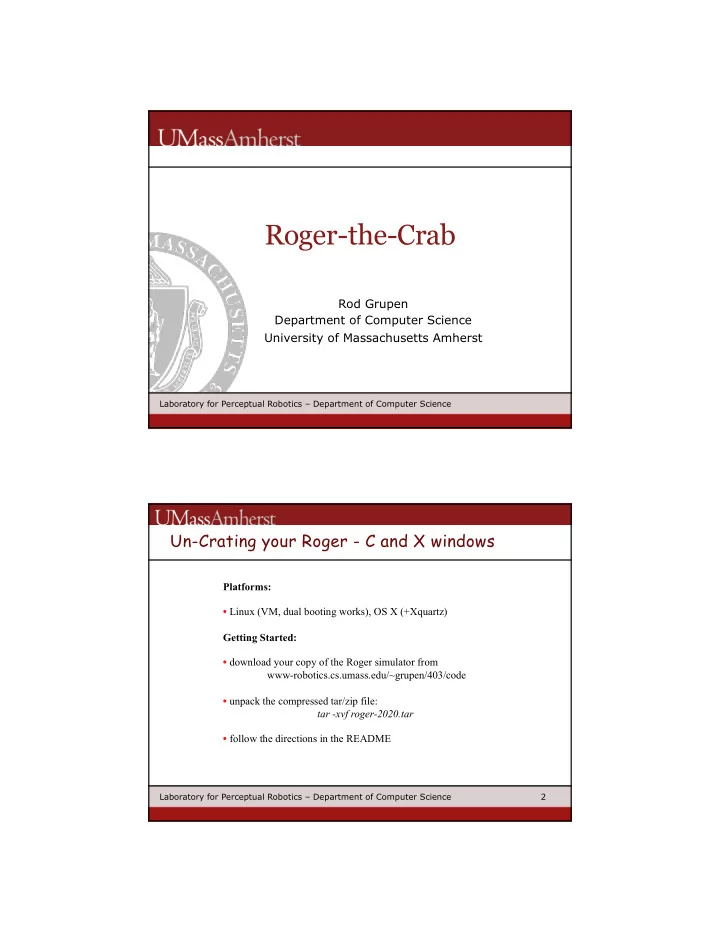

Roger-the-Crab Rod Grupen Department of Computer Science University of Massachusetts Amherst Laboratory for Perceptual Robotics – Department of Computer Science Un-Crating your Roger - C and X windows Platforms: • Linux (VM, dual booting works), OS X (+Xquartz) Getting Started: • download your copy of the Roger simulator from www-robotics.cs.umass.edu/~grupen/403/code • unpack the compressed tar/zip file: tar -xvf roger-2020.tar • follow the directions in the README Laboratory for Perceptual Robotics – Department of Computer Science 2
The Simulator (Development) Environment Laboratory for Perceptual Robotics – Department of Computer Science 3 Input Modes: Joint Angle inputs + p configuration space right button (q 1 ) (q 1 ,q 2 ) left button -p -p + p Laboratory for Perceptual Robotics – Department of Computer Science 4
Input Modes: Base goals Input: Base goal Cartesian space (x,y) world frame Laboratory for Perceptual Robotics – Department of Computer Science 5 Input Modes: Arm goals Input: Arm goals Cartesian space left button right arm (x,y) right button left arm (x,y) world frame Laboratory for Perceptual Robotics – Department of Computer Science 6
Input Modes: Introducing an Object (Ball) Input: Ball position Cartesian space world frame Laboratory for Perceptual Robotics – Department of Computer Science 7 Input Modes: Map Editor Input: Map editor obstacles goals Laboratory for Perceptual Robotics – Department of Computer Science 8
Control Modes Project-specific control 1-Motor Units 2-ArmKinematics 3-Vision 4-SearchTrack 5-StereoKinematics 6-Kalman 7-ChasePunch 8-Path Planning 9-PONG 10-Model 11-Belief Laboratory for Perceptual Robotics – Department of Computer Science 9 Environmental Maps different rooms Laboratory for Perceptual Robotics – Department of Computer Science 10
Command line I/O accurate setpoints, gains, etc for experiments starting/stopping plot data Laboratory for Perceptual Robotics – Department of Computer Science 11 Project Specific Visualization Project/user defined tools location uncertainty path plans potential maps Laboratory for Perceptual Robotics – Department of Computer Science 12
Quiting the Simulator Laboratory for Perceptual Robotics – Department of Computer Science 13 Roger-the-Crab - Kinematic Definition ./include/roger.h Laboratory for Perceptual Robotics – Department of Computer Science 14
Primary Cortical Homunculi somatosensory homunculus motor homunculus Laboratory for Perceptual Robotics – Department of Computer Science 15 Homunculus Man somatosensory motor homunculus homunculus Laboratory for Perceptual Robotics – Department of Computer Science 16
Afferents eyes: . q [2], q [2] , images[2][128][3] • arms: . . q 1 [2], q 1 [2], q 2 [2], q 2 [2] • tactile (force) sensors: f [2] R 2 • U mobile base: . . . position (x, x, y, y), orientation ( q , q ) • bump (force) sensor: f R 2 • U Laboratory for Perceptual Robotics – Department of Computer Science 17 Efferents eye torques: • t [2] arm torques: • t 1 [2], t 2 [2] mobile base: • wheel torques t [2] Laboratory for Perceptual Robotics – Department of Computer Science 18
Hierarchical Control Laboratory for Perceptual Robotics – Department of Computer Science 19 Building Hierarchical Control Code replicated control structure Laboratory for Perceptual Robotics – Department of Computer Science 20
Robot Interface: Project #1, #2 eye joint angles/velocities • images • always on arm joint angles/velocities • tactile (force) sensors • base position (x,y), orientation ( q ) • bump (force) sensor • applications simulator (MotorUnits.c) eye motor torques • arm motor torques • wheel torques • Laboratory for Perceptual Robotics – Department of Computer Science 21 Control Interface - control.h typedef struct Robot_interface { // SENSORS double eye_theta[NEYES]; double eye_theta_dot[NEYES]; int image[NEYES][NPIXELS][NPRIMARY_COLORS]; /* rgb */ double arm_theta[NARMS][NARM_JOINTS]; double arm_theta_dot[NARMS][NARM_JOINTS]; double ext_force[NARMS][2]; /* (fx,fy) force on arm endpoint */ double base_position[3]; /* x,y,theta */ double base_velocity[3]; // MOTORS double eye_torque[NEYES]; typedef struct _map { double arm_torque[NARMS][NARM_JOINTS]; int occupancy_map[NBINS][NBINS]; double wheel_torque[NWHEELS]; double potential_map[NBINS][NBINS]; int color_map[NBINS][NBINS]; // TELEOPERATOR } Map; int button_event; double button_reference[2]; // CONTROL MODE int control_mode; int input_mode; Map world_map, arm_map[NARMS]; // REFERENCE VALUE double base_setpoint[3]; /* desired world frame base position (x,y,theta) */ double arm_setpoint[NARMS][NARM_JOINTS]; /* desired arm joint angles */ double eyes_setpoint[NEYES]; /* desired eye pan angle */ } Robot; Laboratory for Perceptual Robotics – Department of Computer Science 22
Project #1 - Code Structure Laboratory for Perceptual Robotics – Department of Computer Science 23 MotorUnits.c current higher-level _ + S sensory reference state inputs simulator control_roger() control_base() control_arms() control_eyes() control torques Laboratory for Perceptual Robotics – Department of Computer Science 24
Cumulative Project Work 1. motor units 2. Cartesian goals 3. oculomotor behavior 4. visual reconstruction - triangulation 5. � hunting � - integrated behavior 6. … options: 1. path planning 2. learning 3. Pong 4.… Laboratory for Perceptual Robotics – Department of Computer Science 25
Recommend
More recommend